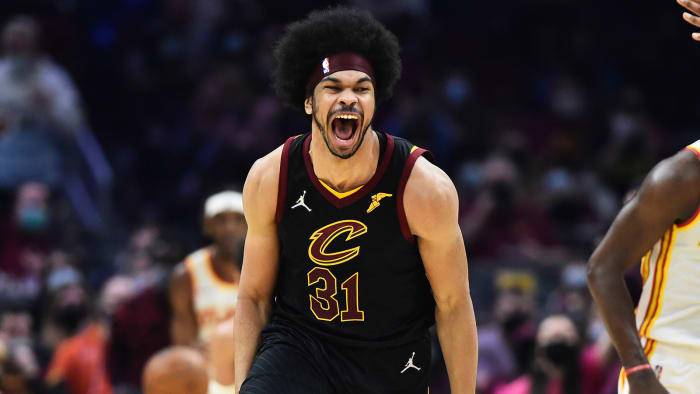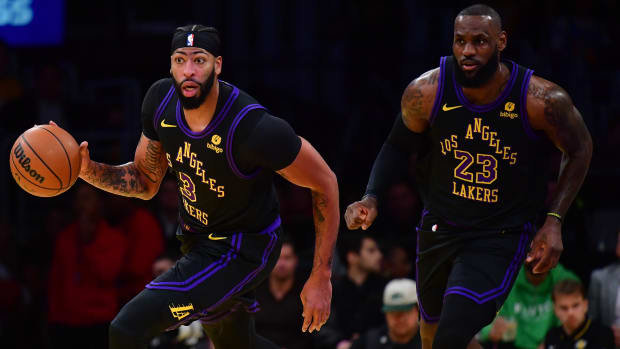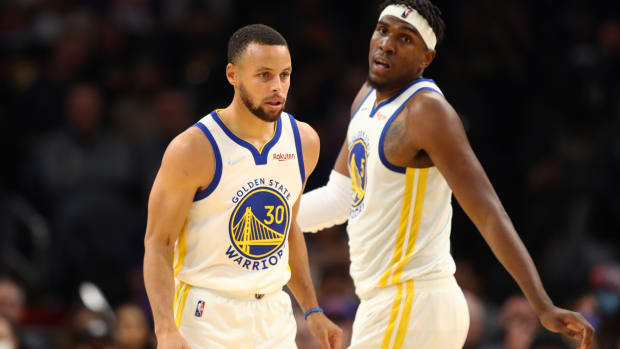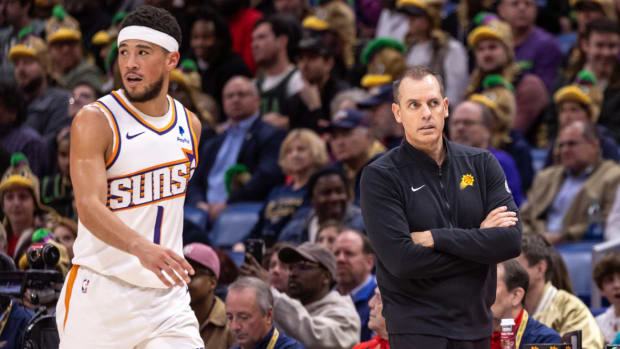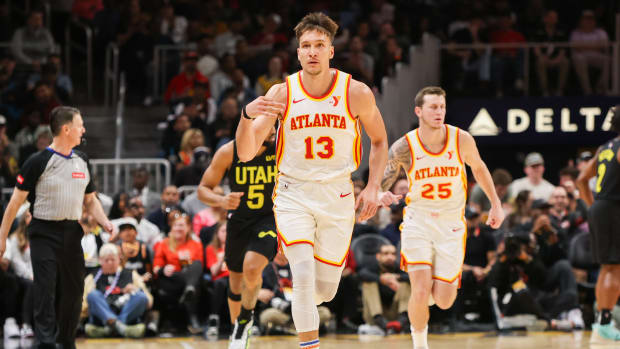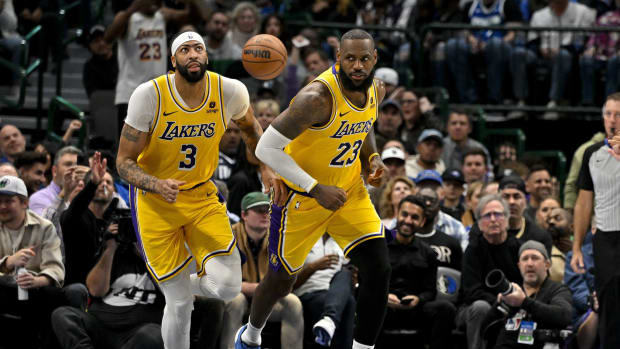Jarrett Allen Is Quietly Making the Unlikeliest All-Star Case
It wasn’t until Christmas Day that Cavaliers center Jarrett Allen started to think about making his first All-Star team. The idea hadn’t crossed his mind before then. It wasn’t a preseason goal or, in Allen’s view, the slightest possibility.
Allen’s four-year NBA existence had been based around thankless motion—rim runs, picks and deep drops—as an offensively limited center whose contributions aren’t associated with stardom. But so far this year, with a wider role on the league’s most pleasantly surprising team, he’s looked the part. When the fan vote officially began on Dec. 25, the ever-modest Allen, 23, was momentarily forced to reconcile with his own ascension.
“All my family kept telling me, 'I'm gonna vote for you. I'm gonna do all this for you.'” Allen says. “And I was like, 'Oh okay, I got a little group behind me to vote for All-Star! That got me a little riled up, but then I kinda forgot.”
On Jan. 6, the first fan vote returns were released by the NBA and among frontcourt players in the Eastern Conference, only Kevin Durant, Giannis Antetokounmpo, Joel Embiid, Jayson Tatum and Jimmy Butler were ahead of Allen, who learned about the results while scrolling through Twitter. He didn’t expect to see his name on the list or receive as many votes as he did.
But as the hyper-efficient anchor for a pugnacious team that leads the Eastern Conference in net rating, Allen is the crème de la crème of an increasingly overlooked and underappreciated archetype, so excellent within his role that everything he doesn’t do (shoot threes, handle the ball, have a usage above 20%) is moot. He’s been the second-best big man in the East, and an emerging candidate for Most Improved Player and Defensive Player of the Year who deserves as much All-Star recognition as anyone else in Cleveland.
Allen leads his team in rebounds, PER, true shooting percentage (where he’s second in the entire league) and win shares (where he’s fourth in the league). Last year he finished 107th in Estimated Plus-Minus. Right now he ranks eighth overall. The Cavs have the NBA’s second-best defense when he’s on the floor, in part because their starting center is more mobile and stout than ever before. (Rookie sensation Evan Mobley certainly helps, and when asked about his own improvements guarding in space, Allen quickly shouts out his teammate: “I’m no Evan Mobley. That guy’s one of a kind.”)
When Allen is in the game, the other team shoots a measly 56.2% at the rim—2.4% below the league-worst Thunder. To get more specific, opponents shoot only 50.3% at the rim with Allen nearby, which is seventh-best out of the 89 players who’ve defended at least 100 shots in that area.
He’s averaging 17 points per game and making 71.8% of his two-point shots, which also leads the league and is up from 63.1% last season. In NBA history, no player has ever made at least 70% of their overall shots while taking 10 or more per game. Allen can be the first. “Everybody's gonna say, 'All he does is dunks and layups.' But hey, I make 70% of those,” he says. “And that's easier said than done.”
Much of that is thanks to his budding pick-and-roll partnership with Darius Garland, whose own growth as a dazzling playmaker can’t be ignored when discussing Allen’s development. When asked about Most Improved Player, Allen quickly lobbies for his point guard as the more deserving candidate. The pair have a natural chemistry that’s generated more at-rim assists than every other duo in the league, except for Trae Young and John Collins/Clint Capela.
“Sometimes you just kind of get in the groove with a guy, with your point guard, and as you start working out you're able to read each other's movements,” Allen says. “In practice, we have plays where we're just practicing pick-and-roll. Even if we're just having fun in practice, just messing around, he's throwing me lobs. I still think that creates a connection.”
During games, Allen will keep constant communication with Garland, tweaking angles, asking if he should hold the screen a beat longer or get out of it a split second sooner.
In addition to honing that key relationship, Allen’s most important preseason goal was to become a better leader despite his soft-spoken persona. That meant preparing his body to be more active for longer stretches; sustaining an energy that everyone else could follow.
During the offseason he worked on his body in ways he hasn’t before. Allen wanted to get quicker moving his feet when switched onto guards along the perimeter (he knew the Cavaliers would switch more this year).
Allen added sprints to his offseason workouts. He hated them, but knew to reach another level they were necessary. One particular exercise sticks out in his head. “All the bigs know this struggle,” he laughs. He’d start at halfcourt, run to the baseline, run back out to the three-point line, back to the baseline, then race to the other end of the court, where he’d repeat the same pattern again and again. “I'd keep on going back and forth, just trying to simulate a real game,” he said.
Allen also worked on post moves, facing up and with his back to the basket. He is comfortable finishing with both hands, and has developed nifty footwork and advanced counters that make feeding him on the block a decent option. (According to Synergy Sports, among all players who’ve finished at least 70 possessions with a post-up, he’s second in efficiency, behind only Marcus Morris. Right behind Allen are LeBron James, Kevin Durant and Jimmy Butler.)
Allen was skeptical that his hard work would ever see the light of day, but now cites it as the one part of his game he’s gotten better at the most. “Honestly, like, we went into the season, Coach [J.B. Bickerstaff] always talks about how there's gonna be a lot of post-up opportunities. I'm like, ‘Okay, okay.’ You know, we're in 2022 now. It's the game of pick-and-roll, and that's what I've been accustomed to all my NBA career,” Allen says. “I'll get maybe one every other game. I'd be happy with that.
“But as the year has progressed, I've been getting more and more per game and it's starting to become a part of my offense now.”
Allen’s growth on both ends has helped reset expectations in Cleveland, on a team that was mocked for acquiring Lauri Markkanen after they gave Allen a five-year, $100 million contract extension … and after Mobley was drafted with the third pick. “You saw all these memes … the whole league's laughing at us. And it's like, 'Okay, but we can work with this,’” Allen says.
When he first signed that contract, Allen felt he had to work harder than ever just to prove he deserved it. He wondered if he should be feeling pressure. “Do I need to be doing more?” Allen asked himself. But today he realizes that being the best version of himself is more than enough: “I got this contract for a reason. I still can be Jarrett Allen, you know?”
Five months later, that also may mean being an All-Star. Even if Allen is the last one who saw it coming.
More NBA Coverage:
• Inside the Year of the NBA's Replacement Players
• NBA Power Rankings: Warriors Lead After Klay's Return
• The Blockbuster Trade Proposal for Hawks and Celtics
• NBA Rookie Rankings: Jalen Green's Shows Growth































